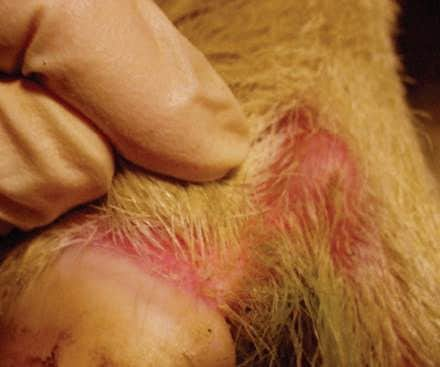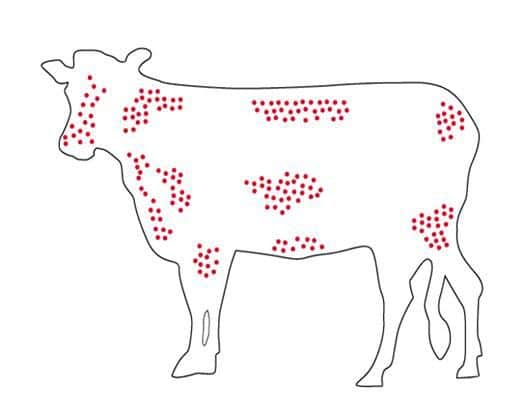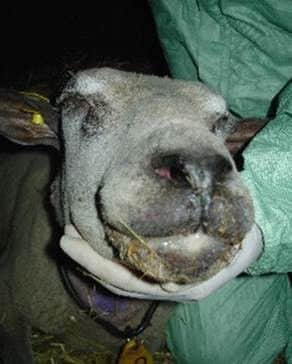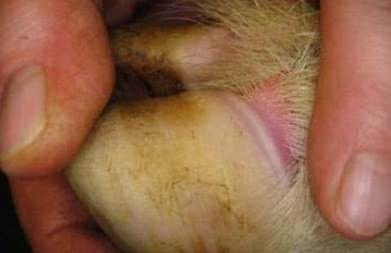Bluetongue: Vets and farmers urged to remain vigilant


Bluetongue virus is a notifiable, midge-borne viral disease which affects all ruminants particularly sheep.
The Department of Agriculture and Rural Development is urging all farmers to report any signs of the disease immediately to their local Divisional Veterinary Office.
How to spot Bluetongue?
Advertisement
Advertisement


The severity of disease varies among different species with symptoms being most severe in sheep. In highly susceptible sheep, morbidity (the percentage of sheep affected) can be as high as 100%. Mortality averages 2-30%, but can be as high as 70%.
In sheep the main signs of Bluetongue are:
l Ocular and nasal discharges
l Drooling as a result of swelling of the tongue and/or ulcers in the mouth


l Swelling of the mouth, head and neck
l Fever
l Lameness as a result of swelling of the coronary band (where the skin of the leg meets the horn of the hoof)
l Red skin as a result of blood collecting beneath the surface


l Breathing difficulties
Advertisement
Advertisement
As the midges prefer to bite cattle, they are the main carriers of Bluetongue. Infected cattle generally do not show signs of the disease, but occasionally signs can include:
l Swelling and ulcers in the mouth
l Nasal discharge


l Red skin and eyes
l Swollen teats
l Tiredness
Other animals such as deer, goats and camelids rarely show signs of the disease. Bluetongue does not cause disease in humans or animals other than ruminants.
How is Bluetongue spread?
Bluetongue virus is spread via midges (Culicoides), which are known as the vector. The disease is mainly spread when midges bite and feed on an animal infected with the virus. Virus then passes to the midge in the blood meal.


In the right conditions the virus multiplies in the midge. When the midge bites another susceptible animal, the virus is transmitted and infection occurs.
Advertisement
Advertisement
The midge season is normally from March to September with peak season in late summer and autumn.
The weather, especially temperature and wind direction, affects how the disease can spread. Midges can travel up to 1.5-2km a day in a local area. However, if caught in suitable meteorological conditions and especially over water masses, midges can be carried much farther distances, of more than 200km.
The virus has been found in the semen of infected bulls and rams and can be transmitted to susceptible cows and ewes, but this is not a significant route of infection. Transmission of disease via midges is by far the most important route of spread.
Virus can also be transferred through the placenta to the fetus.
Disease Control Measures
Advertisement
Advertisement
Good biosecurity can reduce the risk of disease exposure, but BTV-8 is a challenging disease to address because it is spread by midges and therefore the actual actions will depend on the circumstances of the outbreak and whether it occurred in the active vector season.
Research into the use of insecticides against the Culicoides midge species, found a deltamethrin-based pour on treatment to be an effective vector control method. In one study, even hair clipped from the feet of cattle 35 days after standard treatment contained enough deltamethrin to kill midges.
Fly and Lice Spot On™ contains deltamethrin and a vegetable oil carrier which ensures the active ingredient is spread over the whole body and kill is achieved in just two hours at all sites shown in the picture.
When midges land on treated cattle or sheep their feet contact the Fly and Lice Spot On™ and the deltamethrin affects the midge’s nervous system leading to muscular excitement, paralysis and death.
Advertisement
Advertisement
Whilst vector control methods are an important part of a Bluetongue Virus control strategy, and will certainly be useful at a farm level, alone they are unlikely to be successful at controlling disease over a large area, because of the behaviour and movements of the midges.
Vets and farmers involved in the import and movement of livestock should therefore carefully consider the risks and check the health status of animals, especially when sourcing stock from Bluetongue infected countries.
Vaccination is the most effective and practical measure to minimise losses related to the disease and to potentially interrupt the cycle from infected animal to vector.
It is essential to use a vaccine designed to provide protection against the specific strain of virus of concern in a particular area. The strain currently circulating in France is BTV-8.
Currently animal keepers in Northern Ireland are not permitted to vaccinate their animals except under licence.